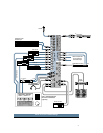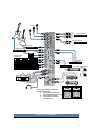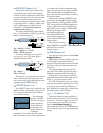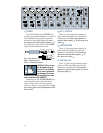
4
L
MONO
L
MONO
L
MONO
L
MONO
LINE IN 7
–
8
RR
R
R
LINE IN 9
–
10
LINE IN 11
–
12
LINE IN 13
–
14
BAL
OR
UNBAL
BAL
OR
UNBAL
BAL
OR
UNBAL
BAL
OR
UNBAL
LINE IN 3
LINE IN 4
L
R
1
2
1
2
RIGHT
AUX SEND
STEREO AUX RETURN
MAIN OUT
LOW CUT
75 Hz
18dB/OCT
LOW CUT
75 Hz
18dB/OCT
BAL
OR
UNBAL
BAL
OR
UNBAL
LINE IN 5
LOW CUT
75 Hz
18dB/OCT
BAL
OR
UNBAL
LINE IN 6
LOW CUT
75 Hz
18dB/OCT
BAL
OR
UNBAL
LINE IN 1
LINE IN 2
MIC
1
MIC
2
MIC
3
MIC
4
LEFT/
MONO
BAL/UNBAL
LOW CUT
75 Hz
18dB/OCT
LOW CUT
75 Hz
18dB/OCT
BAL
OR
UNBAL
BAL
OR
UNBAL
ALL BAL/UNBAL
MIC
5
MIC
6
U
+15-15
U
+15-15
U
+12
-12
HI
12kHz
MID
2.5kHz
LOW
80Hz
EQ
U
+15-15
U
+15-15
U
+12
-12
HI
12kHz
MID
2.5kHz
LOW
80Hz
EQ
U
+15-15
U
+15-15
U
+12
-12
HI
12kHz
MID
2.5kHz
LOW
80Hz
EQ
U
+15-15
U
+15-15
U
+12
-12
HI
12kHz
MID
2.5kHz
LOW
80Hz
EQ
U
+15-15
U
+15-15
U
+12
-12
HI
12kHz
MID
2.5kHz
LOW
80Hz
EQ
U
+15-15
U
+15-15
U
+12
-12
HI
12kHz
MID
2.5kHz
LOW
80Hz
EQ
U
+15-15
U
+15-15
U
+12
-12
HI
12kHz
MID
2.5kHz
LOW
80Hz
EQ
U
+15-15
U
+15-15
U
+12
-12
HI
12kHz
MID
2.5kHz
LOW
80Hz
EQ
U
+15-15
U
+15-15
U
+12
-12
HI
12kHz
MID
2.5kHz
LOW
80Hz
EQ
U
+15-15
U
+15-15
U
+12
-12
HI
12kHz
MID
2.5kHz
LOW
80Hz
EQ
AUX
1
2
MON/
EFX
1
MON/
EFX
1
MON/
EFX
1
MON/
EFX
1
MON/
EFX
1
MON/
EFX
1
MON/
EFX
1
MON/
EFX
EFX
AUX
2
EFX
AUX
2
EFX
AUX
2
EFX
1
MON/
EFX
AUX
2
EFX
1
MON/
EFX
AUX
2
EFX
AUX
2
EFX
AUX
2
EFX
AUX
2
EFX
AUX
2
EFX
TRIM
TRIM TRIM TRIM
TRIM
TRIM
PAN
LR
PAN
LR
PAN
LR
PAN
LR
PAN
LR
PAN
LR
PAN
LR
PAN
LR
PAN
LR
PAN
LR
SOLOSOLOSOLOSOLOSOLOSOLOSOLOSOLOSOLOSOLO
MUTE
MUTE
MUTE
7
–
89
–
10 11
–
12 13
–
14
MUTE
4
MUTE
3
MUTE
2
MUTE
1
MUTE
ALT 3
–
4
ALT 3
–
4
ALT 3
–
4
ALT 3
–
4
ALT 3
–
4
ALT 3
–
4
ALT 3
–
4
ALT 3
–
4
5
MUTE
6
MUTE
LEVEL
+4
-10 -10 -10 -10
LEVEL
+4
LEVEL
+4
LEVEL
+4
TRIM
dB
30
20
10
OO
40
50
5
5
U
60
10
30
20
OO
40
50
60
30
20
OO
40
50
60
dB
30
20
10
OO
40
50
5
5
U
60
10
dB
30
20
10
OO
40
50
5
5
U
60
10
dB
30
20
10
OO
40
50
5
5
U
60
10
dB
30
20
10
OO
40
50
5
5
U
60
10
dB
30
20
10
OO
40
50
5
5
U
60
10
dB
30
20
10
OO
40
50
5
5
U
60
10
dB
30
20
10
OO
40
50
5
5
U
60
10
dB
30
20
10
OO
40
50
5
5
U
60
10
dB
30
20
10
OO
40
50
5
5
U
60
10
ALT 3
–
4
ALT 3
–
4
TAPE
INPUT
TAPE
OUTPUT
L
R
M
I
C
G
A
I
N
+15dB
-45dB
-
1
0
d
B
V
0
60
M
I
C
G
A
I
N
+15dB
-45dB
-
1
0
d
B
V
0
60
M
I
C
G
A
I
N
+15dB
-45dB
-
1
0
d
B
V
0
60
M
I
C
G
A
I
N
+15dB
-45dB
-
1
0
d
B
V
0
60
M
I
C
G
A
I
N
+15dB
-45dB
-
1
0
d
B
V
0
60
M
I
C
G
A
I
N
+15dB
-45dB
-
1
0
d
B
V
0
60
U
OO
+15
U
OO
+15
U
OO
+15
U
OO
+15
U
OO
+15
U
OO
+15
U
OO
+15
U
OO
+15
U
OO
+15
U
OO
+15
U
OO
+15
U
OO
+15
U
OO
+15
U
OO
+15
U
OO
+15
U
OO
+15
U
OO
+15
U
OO
+15
U
OO
+15
U
OO
+15
dB
10
5
5
U
10
dB
10
5
5
U
10
U
OO
+10
U
U
OO
+20
OO
+20
PHONES
28
10
7
4
2
0
2
4
7
10
20
30
LEVEL
SET
LEFT RIGHT
MAIN MIX
SOLO
MODE
LEVEL SET (PFL)
NORMAL (AFL)
C-R/SOURCE
POWER
PHANTOM
RUDE
SOLO
LIGHT
AUX 1
SELECT
EFX TO
MONITOR
AUX 1 MASTER
AUX
RETURN
1
2
PRE
POST
MAIN MIX
CTL ROOM
/SUBMIX
NORMALLED
0dB=0dBu
ALT 3
–
4
TAPE
ASSIGN
TO MAIN MIX
X
D
R
M
I
C
P
R
E
X
D
R
M
I
C
P
R
E
X
D
R
M
I
C
P
R
E
X
D
R
M
I
C
P
R
E
X
D
R
M
I
C
P
R
E
X
D
R
M
I
C
P
R
E
1402-VLZ PRO
14-CHANNEL MIC/LINE MIXER
WITH PREMIUM XDR
TM
MIC PREAMPLIFIERS
U U U
U
U U
PATCHBAY
CHANNEL STRIPS
OUTPUT SECTION
Thank you for choosing a Mackie Designs
professional compact mixer. The 1402-VLZ PRO
is equipped with our new precision-engineered
XDR
TM
Extended Dynamic Range premium
studio-grade mic preamp featuring:
• Full gain range from 0 to 60dB
• +22 dBu line signal handling capability
• 130 dB dynamic range
• Distortion less than 0.0007%, 20Hz to 20kHz
• Bullet-proof RF rejection using DC pulse
transformer circuitry
Now that you have your 1402-VLZ PRO, find
out how to get the most from it. That’s where
this manual comes in.
HOW TO USE THIS MANUAL
Since many of you folks will want to hook up
your 1402-VLZ
PRO immediately, the first pages
you will encounter after the table of contents
are the everpopular hookup diagrams. These
show typical mixer setups for Record/Mixdown,
Video, Disc Jockey and Stereo PA. After this
section is a detailed tour of the entire mixer.
Every feature of the 1402-VLZ
PRO is described
“geographically;” in other words, in order of where
it is physically placed on the mixer’s top or rear
panel. These descriptions are divided into the first
three manual chapters, just as your mixer is
organized into three distinct zones:
1.
PATCHBAY: Along the top and back.
2. CHANNEL STRIP: The ten channel strips
on the left.
3. OUTPUT SECTION: The section on the right.
Throughout these chapters you’ll find illus-
trations, with each feature numbered. If you’re
curious about a feature, simply locate it on the
appropriate illustration, notice the number at-
tached to it, and find that number in the
nearby paragraphs.
You’ll also find cross-references to these
numbered features within a paragraph. For
instance, if you see “To wire your own
cables:
,” simply find that number in the
manual and you’ve found your answer.
Finally, you’ll notice feature numbers like
this:
. These numbers direct you to relevant
information.
This icon marks informa-
tion that is critically
important or unique to the
1402-VLZ
PRO. For your
own good, read them and
remember them. They will be on the final test.
And the final test score will go down on your
Permanent Record.
This icon will lead you
to in-depth explanations of
features and practical tips.
While not mandatory, they
usually have some valuable
nuggets of information.
A PLUG FOR THE CONNECTORS SECTION
Appendix is a section on connectors:
XLR connectors, balanced connectors, unbal-
anced connectors, special hybrid connectors.
More resources on our website @
www.mackie.com
THE GLOSSARY: A Haven of Non-Techiness For
The Neophyte
The "Glossary of Terms" is a fairly compre-
hensive dictionary of pro-audio terms. If terms
like “clipping,” “noise floor,” or “unbalanced”
leave you blank, refer to this glossary for a
quick explanation.
ARCANE MYSTERIES ILLUMINATED
"Arcane Mysteries" discusses some of the
down ’n’ dirty practical realities of
microphones, fixed installations, grounding,
and balanced versus unbalanced lines. It’s a
goldmine for the neophyte and even the sea-
soned pro might learn a thing or two.
INTRODUCTION


















